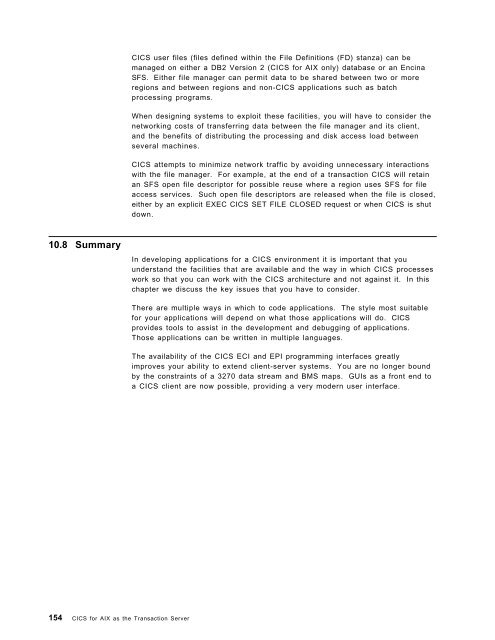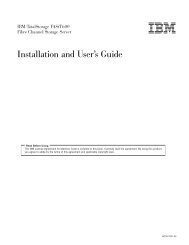Addressing OLTP Solutions with CICS: The Transaction Server ... - Ibm
Addressing OLTP Solutions with CICS: The Transaction Server ... - Ibm
Addressing OLTP Solutions with CICS: The Transaction Server ... - Ibm
Create successful ePaper yourself
Turn your PDF publications into a flip-book with our unique Google optimized e-Paper software.
10.8 Summary<br />
154 <strong>CICS</strong> for AIX as the <strong>Transaction</strong> <strong>Server</strong><br />
<strong>CICS</strong> user files (files defined <strong>with</strong>in the File Definitions (FD) stanza) can be<br />
managed on either a DB2 Version 2 (<strong>CICS</strong> for AIX only) database or an Encina<br />
SFS. Either file manager can permit data to be shared between two or more<br />
regions and between regions and non-<strong>CICS</strong> applications such as batch<br />
processing programs.<br />
When designing systems to exploit these facilities, you will have to consider the<br />
networking costs of transferring data between the file manager and its client,<br />
and the benefits of distributing the processing and disk access load between<br />
several machines.<br />
<strong>CICS</strong> attempts to minimize network traffic by avoiding unnecessary interactions<br />
<strong>with</strong> the file manager. For example, at the end of a transaction <strong>CICS</strong> will retain<br />
an SFS open file descriptor for possible reuse where a region uses SFS for file<br />
access services. Such open file descriptors are released when the file is closed,<br />
either by an explicit EXEC <strong>CICS</strong> SET FILE CLOSED request or when <strong>CICS</strong> is shut<br />
down.<br />
In developing applications for a <strong>CICS</strong> environment it is important that you<br />
understand the facilities that are available and the way in which <strong>CICS</strong> processes<br />
work so that you can work <strong>with</strong> the <strong>CICS</strong> architecture and not against it. In this<br />
chapter we discuss the key issues that you have to consider.<br />
<strong>The</strong>re are multiple ways in which to code applications. <strong>The</strong> style most suitable<br />
for your applications will depend on what those applications will do. <strong>CICS</strong><br />
provides tools to assist in the development and debugging of applications.<br />
Those applications can be written in multiple languages.<br />
<strong>The</strong> availability of the <strong>CICS</strong> ECI and EPI programming interfaces greatly<br />
improves your ability to extend client-server systems. You are no longer bound<br />
by the constraints of a 3270 data stream and BMS maps. GUIs as a front end to<br />
a <strong>CICS</strong> client are now possible, providing a very modern user interface.
















